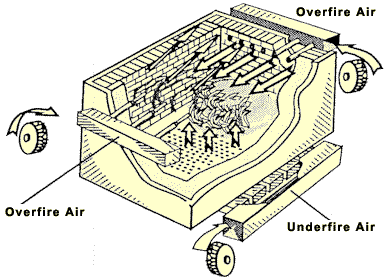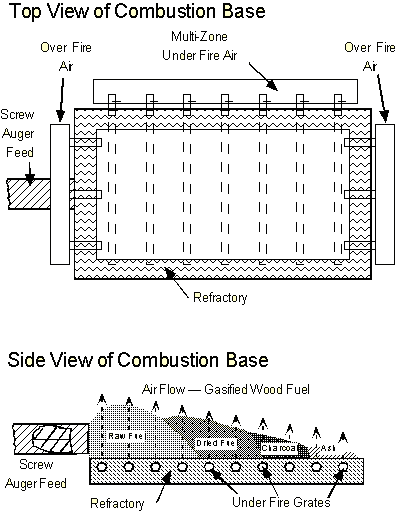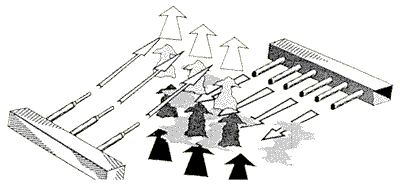|
What others are saying about our shop heaters:
What others are saying about our boilers:
Biomass Combustion Systems, Inc.
67 Millbrook Street Suite 502
Worcester, MA 01606
Tel: (508) 798-5970
Fax: (508) 798-5971
info@biomasscombustion.com
|
|
| Boilers - Horizontal Grate Technology |
The BCS combustion system has met air quality standards without an expensive flue gas filtration system required by our competitors. The reason is simple: Our design incorporates the three components required for efficient combustion of wood fuel - Time, Temperature and Turbulence.

On the grate - low bed turbulence
Our fuel feed system pushes the fuel slowly across the combustion chamber, so the fuel moves like a glacier across the grate. This gentle feeding method minimizes the amount of turbulence on the grate while maximizing the length of time the fuel is exposed to combustion air. By strictly regulating the air flow through the grate and fuel, the BCS design minimizes the amount of fuel lifted off the bed. Since an excess of this air has a cooling effect on the firebox, this strict regulation minimizes the cooling impact of this air and maximizes temperature at the grate where gasification occurs, enabling the fuel to burn more completely.
Above the grate - maximum turbulence
In the upper furnace chamber, overfire air directed from the front and back of the firebox promotes high turbulence that thoroughly mixes oxygen in the air with combustion gases off the grate. BCS uses separate fans for each overfire air manifold to maximize control of this air flow. The design allows the firebox to stay at high enough temperatures for complete combustion even when there is a small load on the boiler and small a fire in the firebox.

Optimized Airflow with Multizoned Air Manifolds
The multizoned grate underfire air system provides flexibility for different fuels - from dry sanderdust to green whole tree chips. Each zone has an external valve allowing you to put more air where combustion takes place and less air farther from the fire. The total amount of underfire air is metered by an electrically controlled master valve as a function of the power demanded by the boiler.
This unique design controls the underfire air through the combustion chamber, unlike designs such as the underfeed stoker that can provide only a single zone in the chamber. With the multizone air system you have a greater degree of control and the fire burns better. Once the initial adjustments to the airflow in each zone have been made, the firebox will burn a spectrum of wood fuels, ranging from 3% to 45% moisture content!
Stationary Grates for More Thorough Combustion
With the BCS feed system, the firebox auger gradually pushes the fuel over the grate and across each underfire air zone. Underfire air passes through the underfire manifolds which typically consists of more than a thousand nozzles. The grate is constructed of durable high temperature refractory floor tiles which are locked in place but can easily be removed if necessary. The grates are cooled by the underfire air for durability and to prevent slagging.
This underfire air system is more expensive to manufacture than competing systems but has several important benefits:
The grates are stationary and have no moving parts to wear or jam.
Our feed method keeps fuel in proportion to oxidation rates because fuel quantity and airflow are both controlled. Step or traveling grates may move too fast or too slow and fuel may not burn efficiency as a result.
The fuel’s slow movement keeps bed turbulence low. The object is not to disturb the fuel but allow it to burn on the grate without becoming airborne or blowing up the stack.
Better control of underfire air promotes better turndown.
Vigorous Overfire Air for Cleaner Burning
During combustion, the underfire air gasifies the wood fuel and the overfire air burns off the resulting gas. The separate front and rear manifolds create an air curtain through which the flue gas must pass.

This air curtain is specifically designed to maximize the turbulence above the fire, use the entire firebox volume and minimize any turbulence on the surface of the pile which would cause unburned fuel to become airborne.
Two fans are provided, one for each overfire manifold, so that an adjustment to one manifold will not affect the air flow to the other. This makes it easier to establish optimum burning conditions.
Advantages to Low Bed Turbulence
Vigorous overfire air in the combustion zone, combined with the slow movement of the fuel and gentle underfire air in the gasification zone promotes low bed turbulence and reduces fly ash.
Underfeed stoking systems which have less underfire air control, burn some fuel in suspension. Other systems blow the fuel into the boiler and burn most fuel in suspension. Once the fuel particles are in suspension they can carry over into the boiler section, reducing the efficiency of the heat transfer in the boiler, increasing tube cleaning maintenance requirements and causing wear on the tubes. If enough of this particulate makes it through the tubes, expensive collection devices which require significant amounts of power to operate could be required to meet air quality standards.
Easy Ash Removal
With the BCS combustion system, most of the ash stays in the rear of the combustion system where it can be raked out as required, generally no more than once a week. When access is available, BCS provides doors along the back and side of the boiler for easy cleanout.
Good Air Control Enables Excellent Turndown Ratios
The modulation of the air through the Horizontal Zoned Grate and the strictly regulated overfire air provides excellent control over the location and quantity of air flows in the boiler. For any size fire the BCS system can maintain higher temperatures in the firebox, and obtain better turndown ratios, than systems which do not strictly regulate this combustion air.
Conservative Sizing:
There are three variables which significantly limit the efficient output of a wood fired boiler:
- Useful grate area
- Useful firebox volume
- Tube surface area in the boiler
BCS uses extremely conservative sizing in designing combustion systems and encourages prospective customers to closely compare BCS proposals to our competitors. |
|

